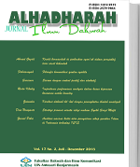BONUS DEMOGRAFI PELUANG DAN TANTANGAN BAGI INDONESIA
DOI:
https://doi.org/10.18592/alhadharah.v16i32.1992Keywords:
demographic bonus, population structureAbstract
Indonesia gets demographic bonus in 2015-2035. Demographic bonus is when the number of productive population of the age of 15-64 years reaches about 70% or about 180 million people and the rest is about 30% or about 60 million people of unproductive age. The demographic bonus is like a double-edged sword. This demographic bonus becomes a profitable phenomenon on the one hand and on the other hand can be disastrous for a country. Beneficial and potential if a country is able to prepare its young generation with a quality generation and vice versa would be disastrous if the state is unable to prepare its human resources. High quality human resources both in terms of education, health, skills so as to compete in the world of work. This phenomenon is of course interesting to be studied further, especially how the opportunities and challenges for diversity in Indonesia.References
Burhan, Lalu, 2017. Buku Sumber Pendidikan Kependudukan. Yogyakarta: Deepublish
Kuncoro, Ari; Sonny Harry B. Harmadi, 2016. Mozaik Demografi : Untaian Pemikiran tentang Kependudukan dan Pembangunan. Jakarta: Salemba Empat
Mantra, Ida Bagoes., 2007. Demografi Umum. Yogyakarta: Pustaka Pelajar
BPS, 2016. Profil Penduduk Indonesia Hasil SUPAS 2015 dalam (https://media.neliti.com/media/publications/48298-ID-profil-penduduk-indonesia-hasil-supas-2015.pdf) diakses tanggal 6 Januari 2017.
Ristekdikti.htm. Mengoptimalkan Bonus Demografi. Diakses tanggal 28 Oktober 2017.
http://www.ilmuekonomi.net/2016/04/pengertian-bonus-demografi-kependudukan-dan-peningkatan-dalam-mensejahterakan-masyarakat.html
https://ugm.ac.id/id/newsPdf/14623-mengoptimalkan.bonus.demografi
https://kumparan.com/@kumparannews/jokowi-indonesia-mendapat-bonus-demografi-tahun-2020-sampai-2030
http://www.ilmuekonomi.net/2016/04/pengertian-bonus-demografi-kependudukan-dan-peningkatan-dalam-mensejahterakan-masyarakat.html
INS-HDR 2016 Indonesia Summary-final.pdf diakses tanggal 28 Oktober 2017)
http://www.ilo.org/wcmsp5/groups/public/---asia/---ro-bangkok/---ilo-jakarta/documents/publication/wcms_381565.pdf
http://www.bkkbn.go.id
http://tekno.kompas.com/read/2017/12/18/07092867/berapa-jumlah-pengguna-dan-pengemudi-go-jek
Downloads
Published
How to Cite
Issue
Section
License
Authors retain copyright and grant the journal the right of first publication, with the work simultaneously licensed under the Creative Commons Attribution-NonCommercial 4.0 International Public License (CC BY-NC 4.0). This license allows reusers to distribute, remix, adapt, and build upon the material in any medium or format for noncommercial purposes only, provided that proper attribution is given to the original creator.







